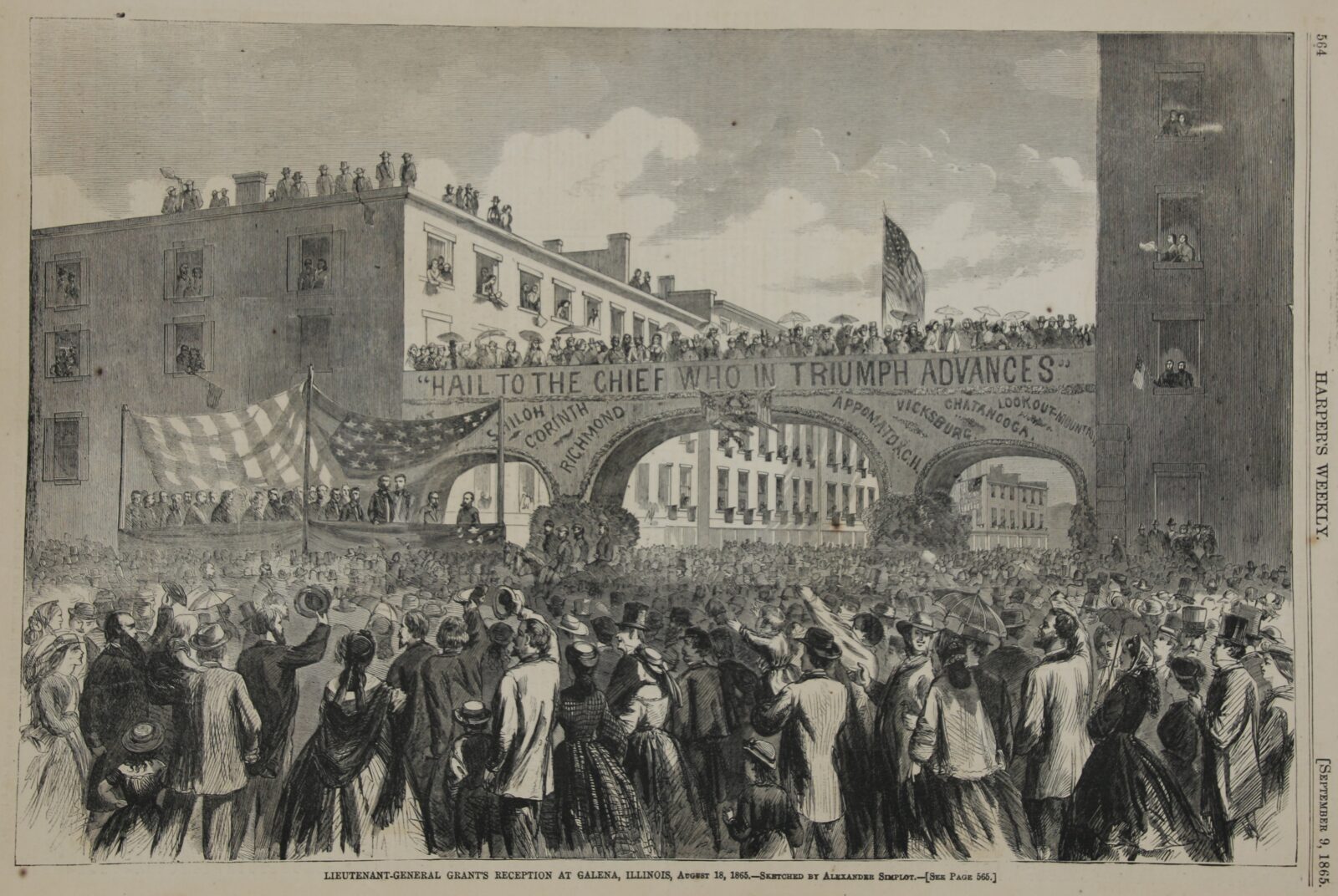In April of 1860, the J.R. Grant Leather & Saddlery Hardware store at 145 Main St. in Galena, Illinois, welcomed a new clerk. The clerk, an 1843 West Point graduate, had left the U.S. Army six years earlier to be with his family and had been struggling making a living outside of military service. Hiram Ulysses and Julia Dent Grant hoped their new home at 121 South High St. in Galena would give them the stable life together they desired to raise their family.
Over the course of the next year Grant would befriend several Galena and Tri-State residents including Dubuque saddlery store owner John Thompson and Galenians Thomas Roberts and brothers James and William Ryan.
Destiny came knocking for Grant one year after reaching Galena with the start of the Civil War in April 1861. With the firing upon Fort Sumpter in Charleston harbor, Ulysses S. Grant offered his military service and experience to the U.S. government without acceptance. Galena resident and U.S. Congressman Elihu Washburne helped Grant secure the rank of colonel leading the 21st Illinois Regimental Infantry. Grant would quickly rise to brigadier general and then major general fighting in the West in Missouri, Kentucky, Tennessee, and Mississippi. By the end of the long and bloody four-year war, “Unconditional Surrender” Grant had risen to the rank of lieutenant general and was appointed Commanding General of the Army by President Lincoln in 1864.
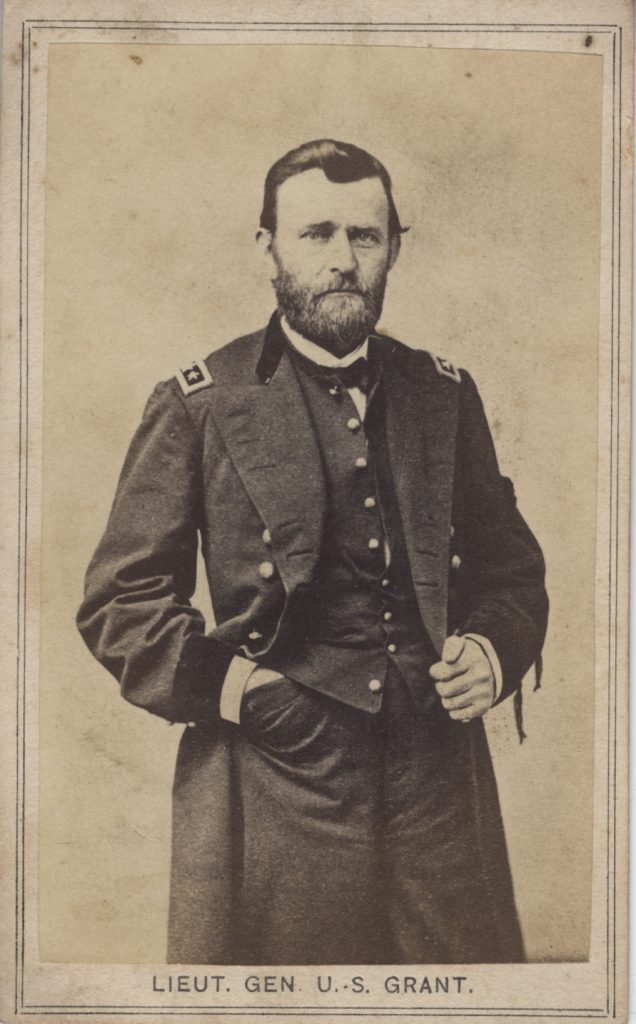
Pictured: Image of Lt. Gen. U.S. Grant taken by Philadelphia photographer Fred. Gutekunst in the spring of 1865. Note the black mourning ribbon hanging from Grant’s left arm in remembrance of the martyred President Lincoln. N.A. Mills of Dubuque sold copies of this image in his Main St. store during Grant’s 1865 visit to the city.
In April 1865, five years after an obscure Ulysses and Julia Grant first moved their family to Galena, Gen. Ulysses S. Grant was immortalized for eternity when he accepted the unconditional surrender of Gen. Robert E. Lee and the Army of Northern Virginia. Within a week of Grant’s triumph, a new and unexpected tragedy was thrust upon the nation with the assassination of President Lincoln. With the passing of Father Abraham, a wounded nation turned to the man Lincoln relied upon to save the Union, Ulysses S. Grant of Galena, Illinois. Grant worked to bring the war to an end and to ensure a peaceful repatriation of the Confederate Army. By August of 1865, Gen. Grant was able to take time off from the recently ended war and return home to Galena for some well-deserved rest.
Pictured: An engraved image by Dubuque artist Alex. Simplot of Gen. Grant’s Galena homecoming in front of the DeSoto House on Aug. 18, 1865. Image published in the Sep. 9, 1865 issue of Harper’s Weekly.
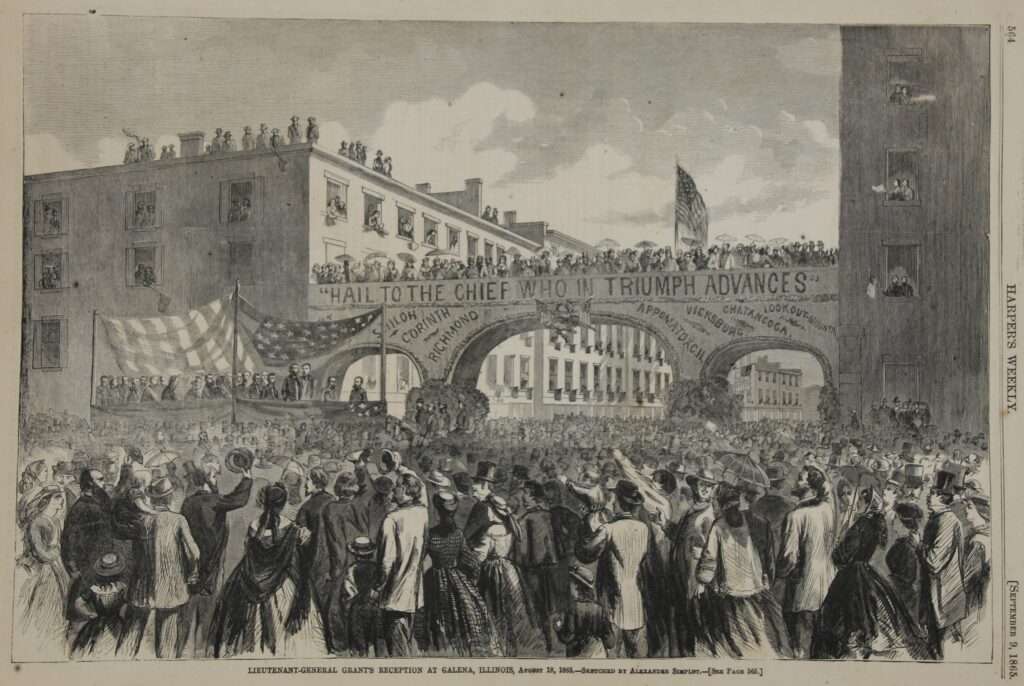
On August 18, 1865, the hero of the war and the savior of the Union arrived at the Galena train depot to an emperor’s welcome. Gathered in front of the DeSoto House, General and Mrs. Grant looked out from the platform upon 20,000 joyful faces squeezed onto Main Street, peering from windows and rooftops, and perched in trees to lay eyes on the mythical Ulysses. Arches spanned Main Street with banners of congratulations and proclamations. One banner read, “General the Sidewalk is Built.” The banner was in response to a statement made to one of Grant’s Galena friends at the start of the war, Thomas Roberts. The General mused to Roberts a few years earlier on a walk to the train depot he might run for mayor of Galena after the war and build much needed sidewalks. Grant’s homecoming was covered in the September 9, 1865, issue of Harper’s Weekly, resplendent with images from the day.
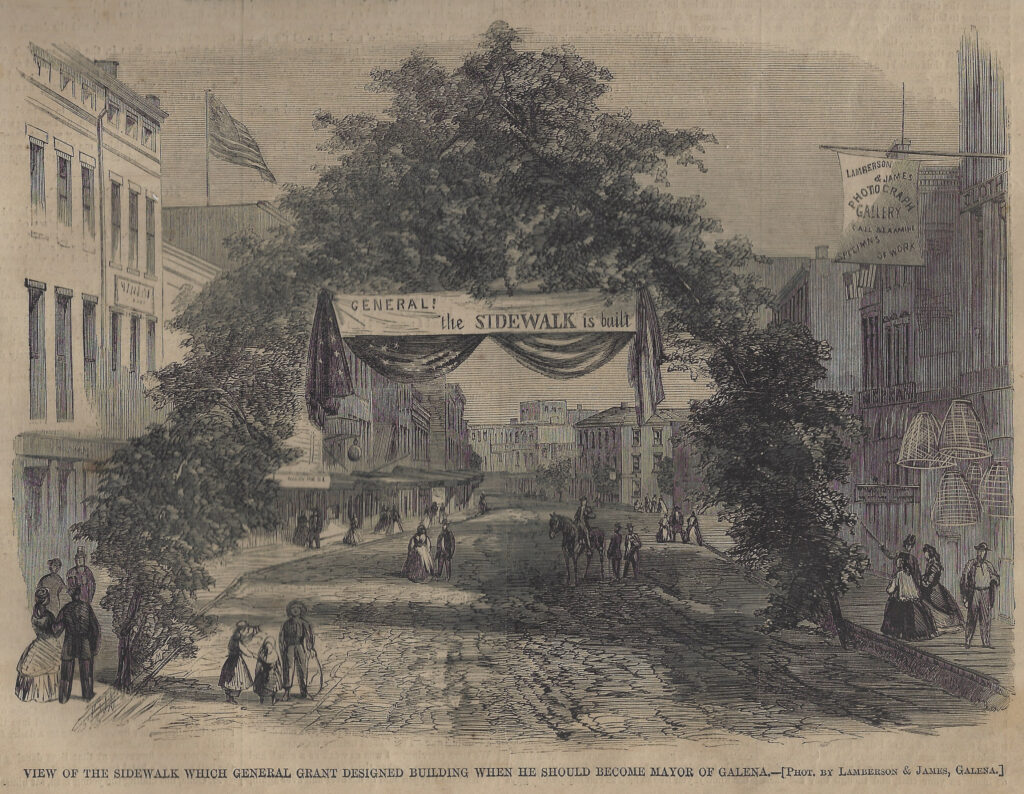
Pictured: A sign over Main Street during Gen. Grant’s Galena homecoming on Aug. 18, 1865. Image published in the Sep. 9, 1865 issue of Harper’s Weekly.
The following week Grant, along with his family and Galena friends, including Rep. Washburne, were welcomed to Dunleith (East Dubuque) at 2:00 p.m. with canon fire from the eastern and western bluffs overlooking the Mississippi River valley, letting the city of Dubuque know Gen. Grant had arrived. The Grant party crossed the Mississippi River on the Dunleith-Dubuque Ferry with a welcoming party including Dubuque Mayor and Grant’s friend, John Thompson. The parties then loaded into carriages and proceeded to parade through the city of Dubuque along a published route that ran from the port of Dubuque west on Jones Street to Main Street, heading north on Main Street to 13th Street, east on 13th Street down the hillside to Iowa Street and City Hall, turning south on Iowa Street heading towards Sixth Street, and finally west on Sixth Street to the throngs of people celebrating in and around Washington Square.
Lt. Gen. Grant was introduced to the Dubuque crowd by recently returned Dubuque Major Gen. William Vandever, a former U.S. Congressman and colonel of the 9th Iowa Regimental Infantry. Grant, a man of few words rose, reviewing the crowd of 30,000 like he might his Army, paused and said, “Ladies and gentlemen, I am glad to meet you. You all know I am not accustomed to making speeches, and if I were, I could not find words to express to you my thanks for this hearty welcome.” Nodding and waving to the crowd, Grant stepped back and took his seat.
After Rep. Elihu Washburne addressed the crowd on behalf of the General, the Grant party was taken on a tour of Dubuque along the bluffs overlooking the city and the Mississippi River valley before heading to the Julien House (today’s Hotel Julien Dubuque) for a public reception and banquet. At 9:00 p.m., the General and Mrs. Grant, the general’s father Jesse Grant and a brother, and the rest of the Galena delegation crossed the river and boarded the train back to Galena.
On August 28, 1865, the Jo Daviess Soldier’s Monument Association printed certificates for their fund drive for a soldier’s memorial to be erected in Galena. Gen. Grant was elected the association president and Galena’s brevet general John C. Smith elected secretary. Both men signed the certificates given to those who donated, or “joined,” the association. Grant signed a stack of unissued certificates to be assigned after his departure from Galena on September 12, 1865.
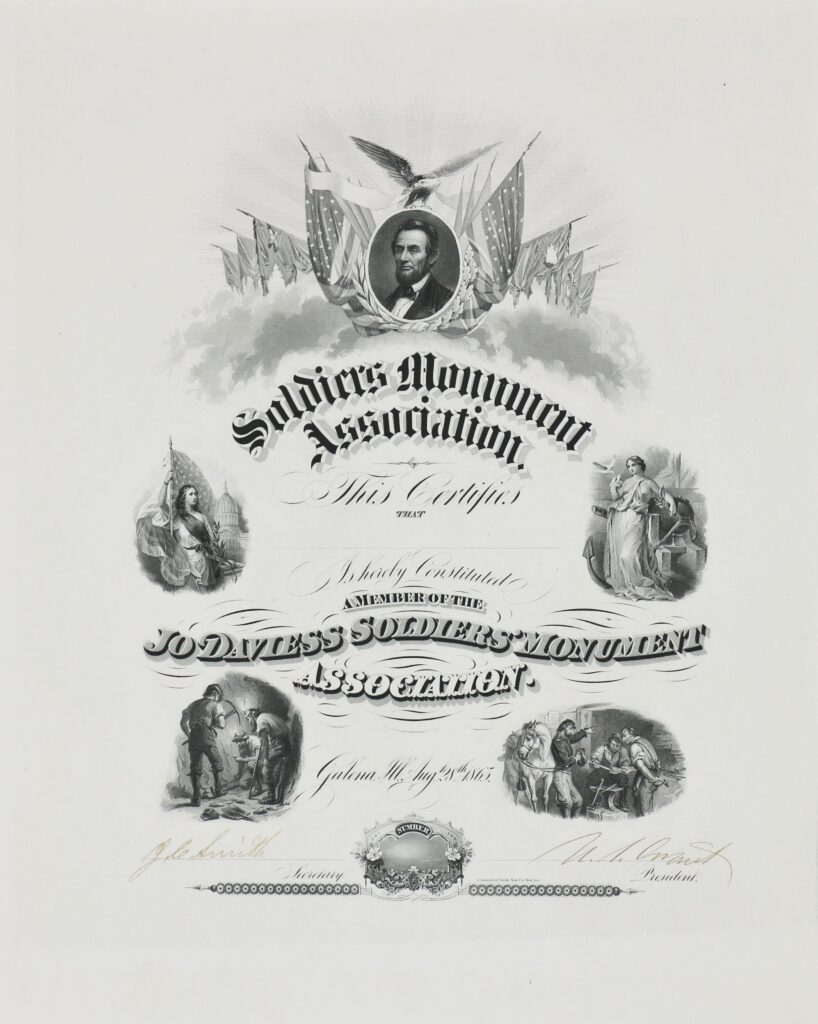
Pictured: Unissued Jo Daviess (County) Soldier’s Monument Association certificate signed by association president Lt. Gen. U.S. Grant and secretary Brevet Br. Gen. John C. Smith.
General and Mrs. Grant would return to their Galena home at 500 Bouthillier St. (an Italianate mansion given to the Grant’s by their Galena neighbors in 1865) from August 7, 1868, to November 5, 1868, when the General ran for President of the United States from his headquarters in the DeSoto House hotel. On Tuesday, November 3, 1868, the Commanding General of the Army – Ulysses S. Grant – was elected Commander and Chief of the United States. During his two-term presidency, President Grant returned to his home in Galena twice for brief stays while on visits to the West. Galena hosted the sitting president during visits September 28-30, 1871, and again May 1-3, 1873.
PIctured: Grant’s second Galena residence at 500 Bouthillier St., given to the Grants in Aug. 1865. Image published in the Sep. 9, 1865 issue of Harper’s Weekly.
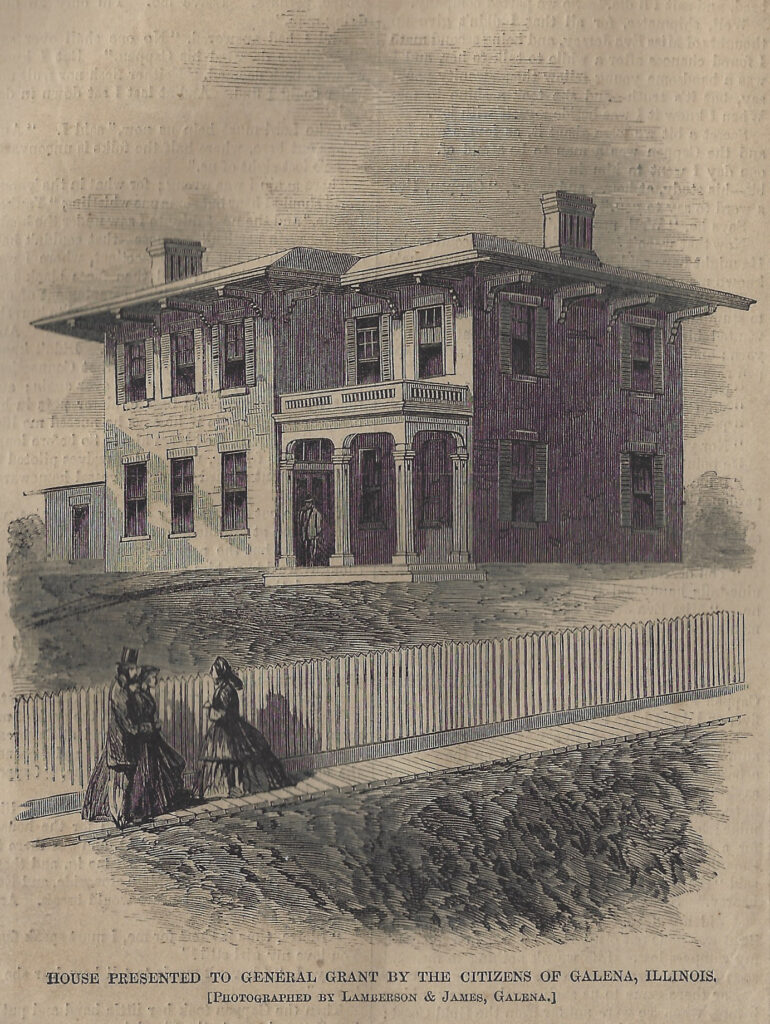
At the end of his presidency in March of 1877, General and Mrs. Grant returned to Galena April 7-10, before leaving for a two-and-a-half-year world tour. The Grants returned to the U.S. from a wildly popular tour to a hero’s welcome on September 20, 1879, before returning to Galena November 5 thru December 3, 1879, before leaving again for a southern winter tour. On December 1, the Grants attended a charity ball in Dubuque for the Home for the Friendless at the invitation of their close friends Mr. and Mrs. John Thompson. After attending a private meal at the Thompson’s home at 1375 Locust St., the Grants attended the charity ball at the Julien House.
After spending the winter traveling Texas, Mexico, and Cuba, the Grants returned to their home in Galena on April 19, 1880. At this time the General was considering running for an unprecedented third term as president as the Republican convention was being planned for nearby Chicago in June. During this time the Grants lived the semblance of a normal life during their stay in the Tri-State area. Or as much as a man running for a third term as president can live a normal life. The Grants took time to visit St. Clara Academy for girls at Sinsinawa Mound in southern Wisconsin where they met some of the young students. The general told the Dominican Sisters that on the battlefield he would often think of the Mound and wished he had a similar “eminence” from which he could have better directed his Army.
In May, the Grants made visits to Dubuque to visit with Mr. and Mrs. William “Hog” Ryan and Mr. and Mrs. John Thomson. Their May 24 visit included a tour of Dubuque and Linwood Cemetery. The Grants spend May 30 and June 1 with the Thompson’s at their home on Locust Street. The Grants would often reciprocate and invite the Thompsons for meals and cordial visits to their Galena home.
At the Republican National Convention in Chicago in June, Dubuque’s Republican rising star David B. Henderson gave a speech opposing a Grant third-term presidency. Henderson, like most Americans, loved and respected Gen. Grant and did not oppose the man nor his policies or principles. The opposition arose from the deferential status George Washington held among Americans and the two-term standard he set at the end of his presidency. Henderson, a Civil War veteran, won national notoriety for his speech and Grant quickly fell from the top in subsequent balloting until dark horse Gen. James A. Garfield was elected as the 1880 Republican nominee for president. Grant worked tirelessly from his home in Galena, making trips on behalf of the campaign until election day, November 2, 1880, when Grant cast his vote for James A. Garfield in a Galena ballot box.
The stay between April to November 1880 in Galena was the second longest Galena stay by the Grants, second only to their pre-Civil War stay. Gen. Grant would stop in Galena one last time on May 26-27, 1883, never to return thereafter. On July 23, 1885, Gen. Ulysses S. Grant, a man known to the world as the savior of his nation, passed into immortality. Grant would loom large in the pantheon of American heroes – second only to Washington – from the end of the Civil War until the rise of the Lincoln Memorial in 1920, when American sentiment shifted from Grant toward Lincoln as the savior of the Union as larger numbers of Civil War veterans began to pass into Valhalla.
Galena was considered the Grant family home from 1860 to 1881. In April of 1904, forty-four years after the Grants first moved to Galena, their son Colonel Frederick Dent Grant deeded the family home on Bouthillier Street to the City of Galena “to be kept as a Grant Memorial Home for all time.” You can still tour the home today.
[FROM THE ARCHIVES is a periodical focusing on interesting stories behind artifacts in the Library of John T. Pregler.]

